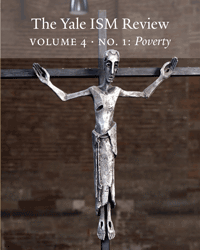Sara Miles
A few months back, I began the morning pretty grumpy. I’d arrived at my local parish, St. Gregory of Nyssa Episcopal Church in San Francisco, hoping to have a nice, peaceful moment chanting the Psalms. But there were already two huge trucks outside the gates, idling noisily, waiting to deliver food for The Food Pantry, which takes place in the middle of the sanctuary every Friday. By the time Morning Prayer was over, the enthusiastic driver had brought in more than a dozen pallets: somewhere around six tons of yams, onions, new potatoes, black beans, noodles, cabbage, rice, carrots, oranges, chicken sausage, and a towering stack of organic Belgian endive. And that was before we even got the nine gigantic sacks of bread.
They’re generally very poor. They might be widows or foreigners, blind or mentally ill, undocumented immigrants from Guatemala, Congo, or China, drug users, head-injured guys, feeble old men or sullen teenage girls with babies.
I gave the driver a cup of coffee, and our volunteers started straggling in and unpacking the pallets and setting up tables in a circle around the altar, and then, grumpily, I tried to figure out what to cook for their lunch. We usually have about forty volunteers, almost all of them people who came to get food and stayed to feed others. They’re generally very poor. They might be widows or foreigners, blind or mentally ill, undocumented immigrants from Guatemala, Congo, or China, drug users, head-injured guys, feeble old men or sullen teenage girls with babies. But one way or another many of our volunteers don’t always get enough to eat during the week. So we like to sit down together for a big family meal before we open the pantry at noon and start giving out free groceries to the crowds.
I rushed to the neighborhood store to buy supplies for lunch: a nice quick minestrone, figuring I’d use up some of that stupid endive in a salad, since I doubted we could give it all away, especially to the Chinese grandmothers who are deeply suspicious of anything white ladies tell them is tasty. When I came back from shopping one of our tweakier volunteers blurted out: “Sara? We’re gonna have at least sixty people for lunch today, OK? Oh, I forgot to tell you to buy milk for coffee. Can you go get some now, OK? And there’s so many helpers we’re ahead of schedule, so can we eat early, Sara, OK?”
Yeah, OK, I said, and then slammed my finger in the cabinet door, and had a snippy little exchange with another even more persistent volunteer, and the pilot light on the stove was broken, and by the time St. Gregory’s priest, my dear friend Paul, walked into the church kitchen, all happy and enthusiastic and ready to help cook, he looked at me and stopped and said, “What’s the matter?”
“We have sixty volunteers for lunch,” I told him bitterly. “And there’s gonna be a huge crowd getting groceries this week, since it’s the end of the month. And now everyone wants to eat early.”
“Great!” said Paul. I looked at him as if he were insane. “That’s great, because what are we trying to do here? Feed as many people as possible, right?”
He was, irritatingly enough, right. I tried to focus on feeding as many people as possible. And when I got home from the pantry—actually we only served 420 people, and there was enough minestrone left over to send home with Paul, and we did get rid of all the bread and even the Belgian endive, every single bit of it—when I got home, exhausted and, despite my best efforts, still sort of grumpy, there was a postcard from a former volunteer, Alice, a wacky evangelical Black grandmother who now lives in Georgia. “I know,” she’d scrawled, with a smiley-face, “the people are just bursting with joy of love and laughter to know that Jesus Christ is always at St. Gregory of Nyssa Food Pantry every week providing a Great Big Bundle of Bountifulness of Blessing there. Blessings!”
Jesus is real, because there are eight tons of real food, right here on earth, feeding as many hungry people as possible. My flesh is real food.
Which is to say that Alice, like Paul and everyone else at the pantry, understands what the Gospel truly means: Jesus is real, because there are eight tons of real food, right here on earth, feeding as many hungry people as possible. My flesh is real food.
And then I remembered that I’d promised to visit my four-year-old friend Sophie that evening for her favorite activity, one many four-year-olds love: a tea party. The four-year-old pours the imaginary tea, usually into doll cups, and you pick it up and pretend to sip. “My,” you say, “how delicious! Thank you! May I have some more tea, please?” And the child, delighted, pours you some more imaginary tea. Endlessly. It’s like attending the kind of church where the most important things in the room appear to be the pristine white linen decorously draping the altar, and the silence and obedience and respectability of the parishioners, and the absolute whiteness of the perfectly round, completely salt-free, gluten-free, odorless, tasteless and flavorless communion wafers. You creep forward quietly. “The blood of Christ,” someone dressed in sexless robes whispers. They hold a toy goblet of pale wine for you to take a miniscule sip. “Amen,” you say, and they wipe it off with another white napkin. And the server offers the next guest a sip of imaginary blood.
Which is to say that the white-tablecloth church server, like my four-year-old friend Sophie, understands what the Gospel truly means: Jesus is real, because there is a precious gift revealed in the offering of a deep, beautiful ritual that transcends the literal and the material. I am the living bread that comes down from heaven.
And this is Eucharist. All of it. We cannot reduce truth to only one level: believing instead of really eating; eating instead of really believing. The redeeming, revolutionary thing about Communion it that it means both things. Heaven and earth. Body and soul. The Eucharist is real because it unites the hungry people at the food pantry and the hungry people at the altar rail. It unites the poetry of a child’s tea party with the physicality of the chicken sausage messing up our floor. It unites ordinary people like us––who are, after all, flesh and blood and spirit––with God in Christ, who is flesh and blood and spirit.
Life in Jesus is not disembodied. Just in case you miss that point, remember how Jesus invites his friends to eat him in one of the more upsetting passages in John’s gospel, using a very particular verb. He doesn’t invite us to dine or to savor. He asks us to “munch” or “gnaw” on his flesh, using a graphic word that describes hungry, noisy eating, the sort of eating that an animal does. This is eating that is urgent, even desperate. It’s chomping on Jesus as if gnawing on a barbequed pork rib. It’s eating as though life depends on it—because it does.
So our eating of Jesus is not spiritual in the sense that it’s make-believe. It’s not an abstract, ritual performance in which we take the bread and wine of Holy Communion as if the phrase “Christ’s body and blood” were merely a poetic metaphor. This bread, this flesh, is real.
But Communion, also, is not just about physical food—like the manna our ancestors ate, or the tons of groceries we share at the pantry—food that we eat, and then die. Eating Jesus is profoundly spiritual in the sense that the Holy of Holies enters our human bodies, in order to change us into the likeness of God.
Jesus asks us not only to eat him but to become him: a mystery which lives fully in, and yet transcends, our mortal flesh. In the words of the great Johannine scholar Maurice Sendak, “I’m in the milk and the milk’s in me.”
Furthermore, in the most spiritual and unworldly, the most concrete and demanding statement of all, Jesus proclaims that everyone who eats him becomes him, and thus—the real scandal of the Incarnation—we all become part of each other. My individual self, still chomping on my sparerib or chewing my Belgian endive—that self, when I eat Jesus, becomes irrevocably connected with others, and I share in their life, too.
You can’t eat Jesus and stay the same.
I received my First Communion about eighteen years ago, and for quite a while I hoped that it would make me a better person. Nicer, mostly. And more spiritual. But it made me more physical, drove me to a messy church kitchen where I’d grumpily complain about feeding people. It made me less private, and far less pure. I got contaminated by everyone else who eats Jesus: the loopy evangelical lady from Georgia and five hundred poor, hungry strangers and white-robed Eucharistic ministers. My body and blood got mixed up with everyone else’s. Eucharist means there’s a likely to be a trashy marshmallow candy bar on the same plate as the organic Belgian endive, and some chunks of flesh floating in the holy chalice.
And so we give it all away, as bread for the world to feed on. We offer our literal flesh and blood, our eight tons of groceries, our imaginary tea and our ritual poetry.
And we thank God for making it real. The Eucharist isn’t intended to help us take on good deeds out of pious obligation, or liberal guilt, or because we think we should be nice. It’s not meant to encourage us to consume more beautiful, tasteful rituals, or rest in our own uplifting feelings. Jesus asks us to eat his flesh and drink his blood so that we’ll be transformed into one body, his body: so that we will become the body that God is raising from the dead.
 Sara Miles is the author of Take This Bread: A Radical Conversion; Jesus Freak: Feeding Healing Raising the Dead; and City of God: Faith in the Streets.
Sara Miles is the author of Take This Bread: A Radical Conversion; Jesus Freak: Feeding Healing Raising the Dead; and City of God: Faith in the Streets.
www.saramiles.net
